Major 7th chords (often written as maj7) add a beautiful, sophisticated color to your guitar playing. Building upon the familiar major triad, the maj7 chord incorporates a major 7th interval, resulting in a richer, more complex harmonic texture. If you’re looking to expand your chord vocabulary and bring a touch of elegance to your music, understanding and utilizing major 7 chords is a must. This guide will break down the essentials of major 7 chords on guitar, covering their theory, shapes, and practical applications in chord progressions.
Understanding the Major 7th Interval
At its core, a major 7th chord is simply a major triad with an added note – the major 7th. Let’s take a C major triad as an example, composed of the notes C, E, and G (root, major 3rd, and perfect 5th). To transform this into a Cmaj7 chord, we introduce the major 7th interval, which in the key of C, is the note B. Therefore, Cmaj7 consists of the notes C, E, G, and B (1, 3, 5, 7).
Audibly, the major 7th interval is just a semitone or one fret below the root note of the chord. Think of it as replacing the higher octave root that you might sometimes find in a basic chord voicing. This subtle shift creates a significant change in the chord’s character, lending it a jazzy, smooth, and often slightly melancholic feel.
Consider the difference in sound: a standard C major chord is bright and cheerful, while a Cmaj7 chord adds a layer of depth and sophistication. Experiment with playing a major chord and then its major 7th counterpart to truly appreciate the nuanced difference.
Major 7th Chord Shapes on Guitar
The good news is that transitioning from major chords to major 7th chords on guitar is often a simple adjustment. Because we are only adding one note, many major chord shapes can be easily modified to create maj7 chords.
Below, you’ll find common major chord shapes alongside their major 7th variations. Practice moving between the major and maj7 versions of each chord, focusing on hearing and feeling the subtle but impactful change. Pay attention to the root notes (marked in red) to understand how these shapes are built.
Open Position Major 7 Chords
Open position chords are fundamental for guitarists, and incorporating maj7 versions into your playing opens up a world of sonic possibilities.
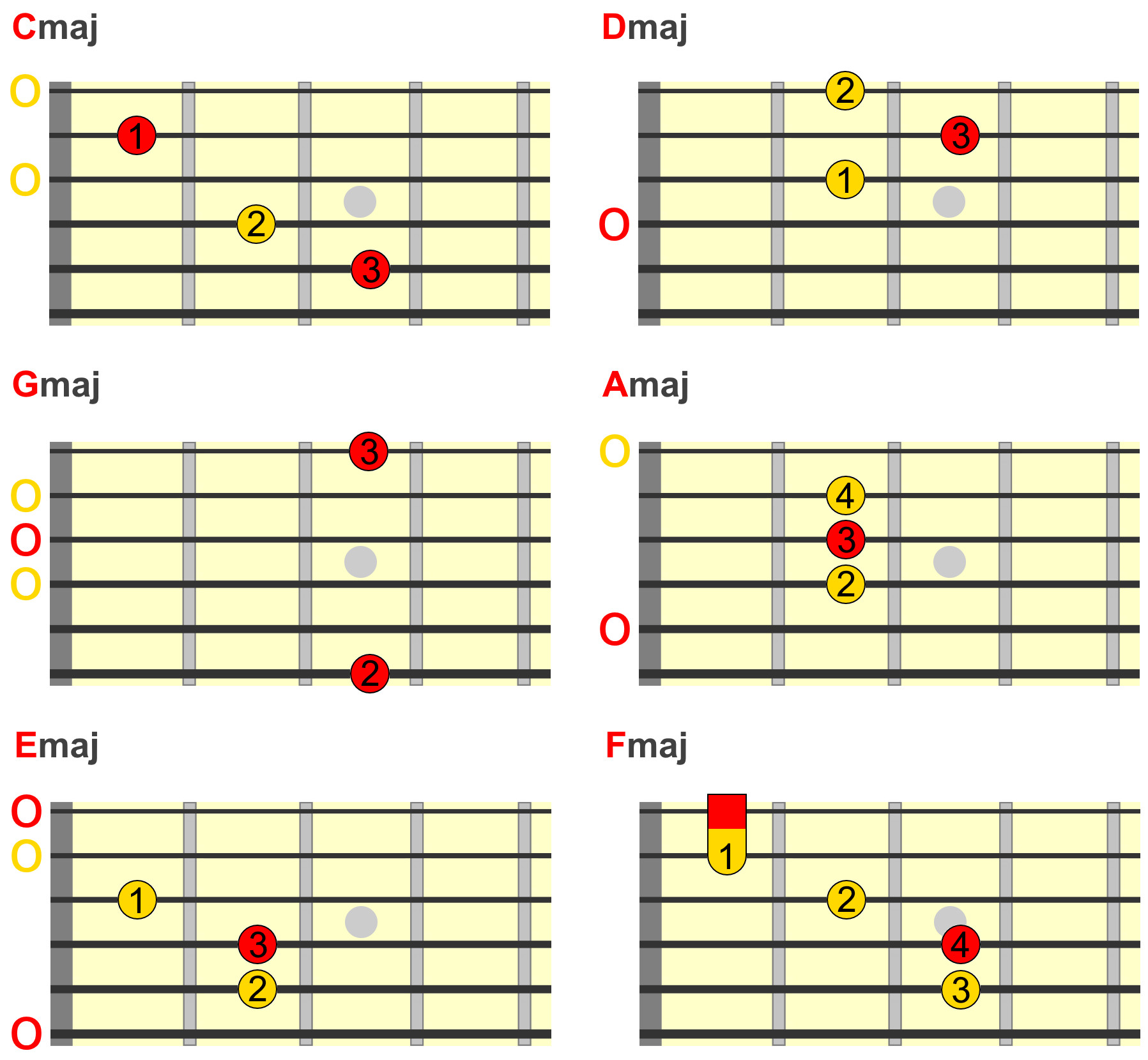 Open major triad chord shapes for guitar
Open major triad chord shapes for guitar
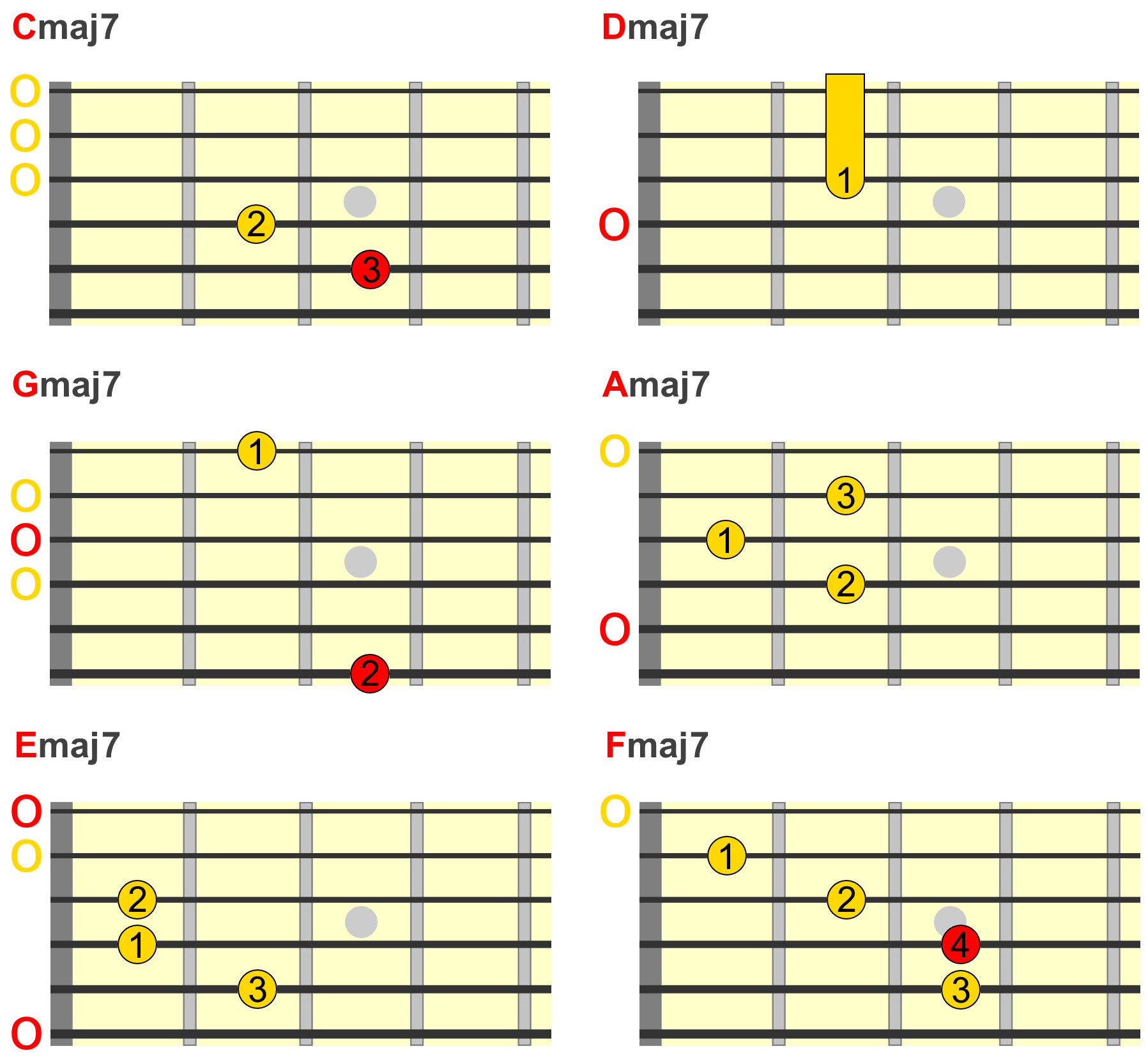 Open major 7th chord shapes for guitar
Open major 7th chord shapes for guitar
Movable Major 7th Chord Shapes
Movable chord shapes are invaluable for playing chords across the guitar neck. These maj7 movable shapes allow you to play major 7th chords in any key.
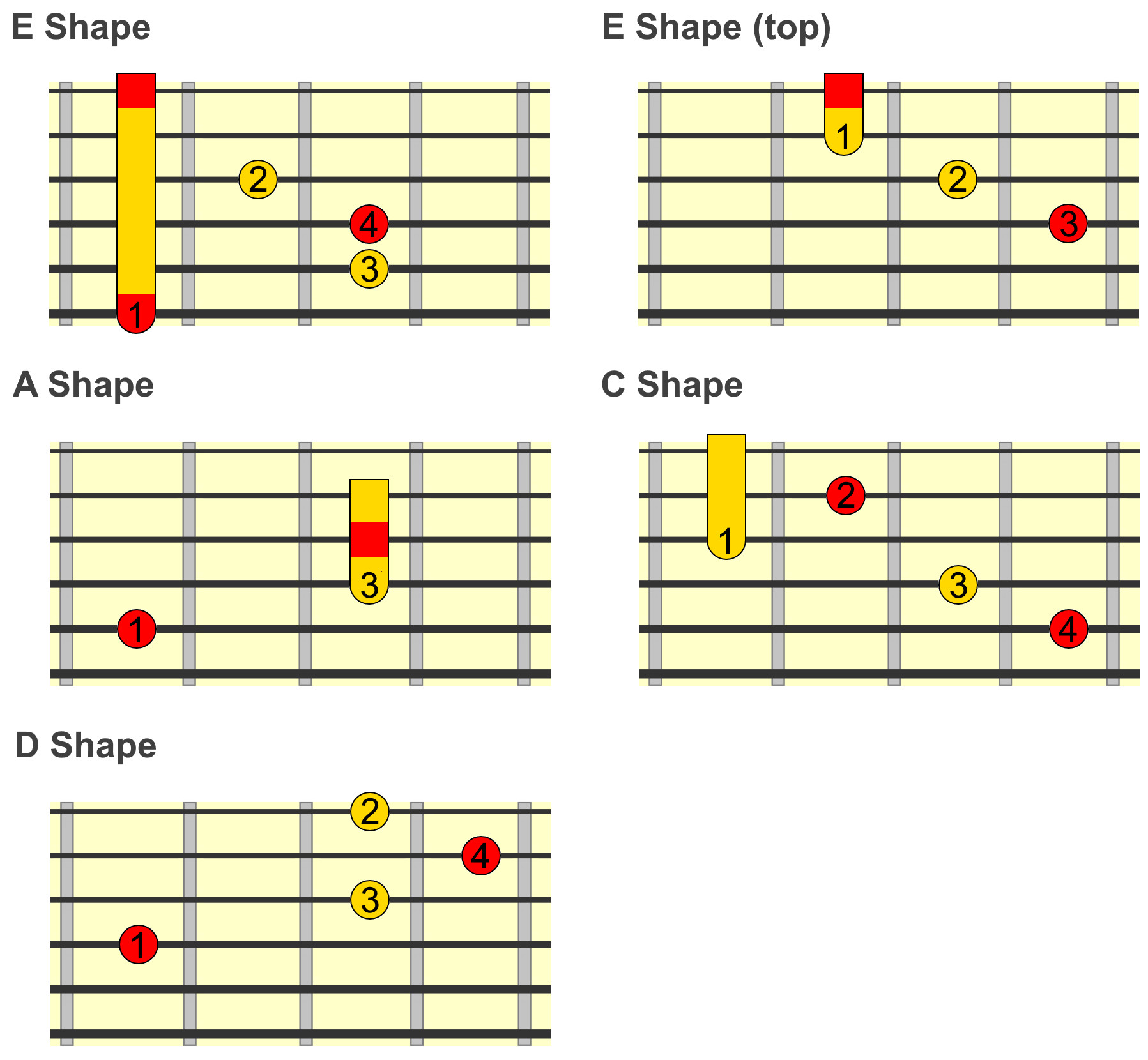 Movable major triad chord shapes for guitar
Movable major triad chord shapes for guitar
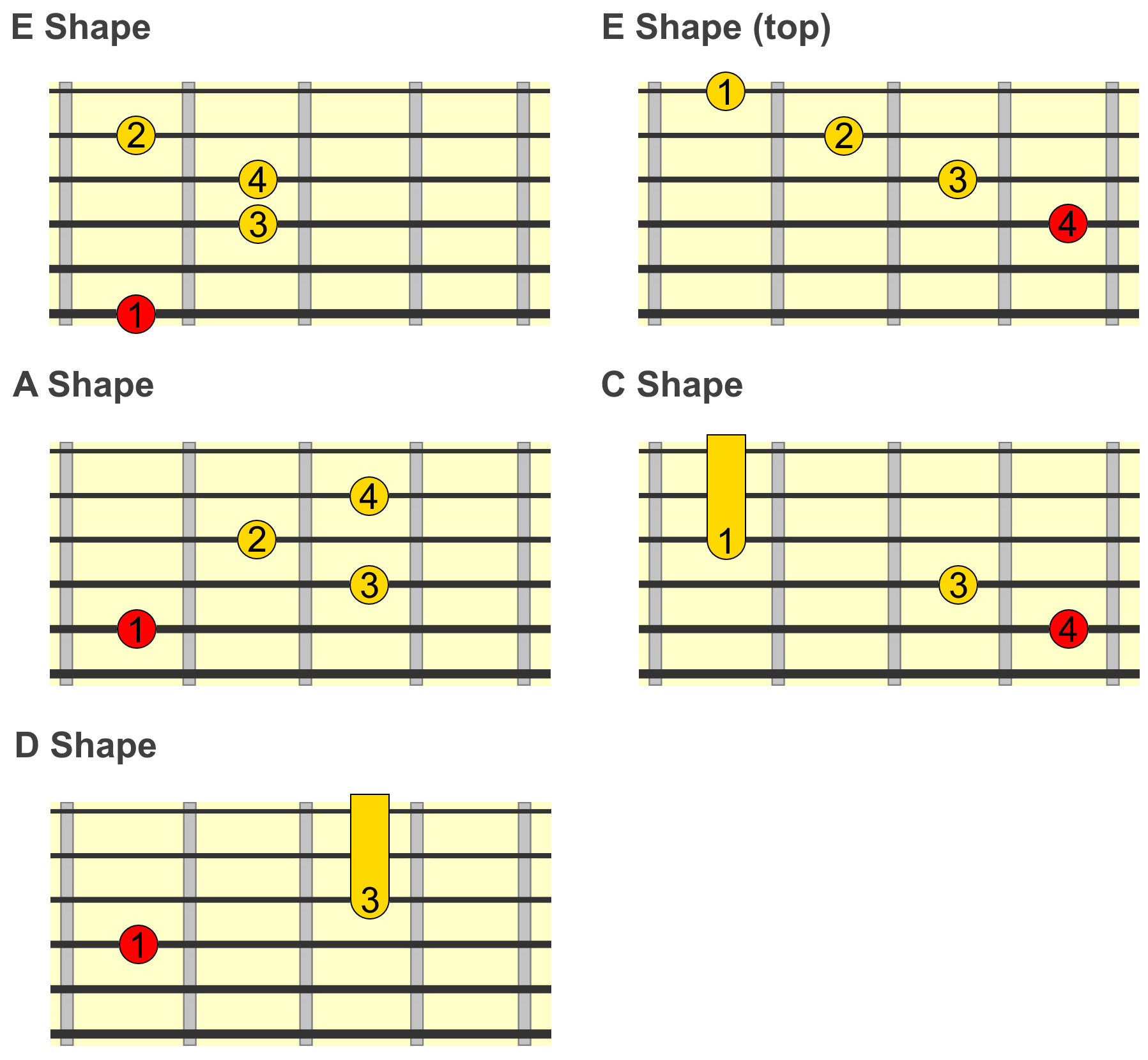 Movable major 7th chord shapes for guitar
Movable major 7th chord shapes for guitar
Utilizing Major 7th Chords in Chord Progressions
Major 7th chords occur naturally within both major and minor key chord progressions. Understanding where they typically appear can significantly enhance your songwriting and improvisational skills.
When we harmonize the major and minor scales, we uncover the diatonic chords of each key, revealing where major 7th chords naturally fit. The table below illustrates the natural 7th chords within common major and minor keys, highlighting the scale degrees where maj7 chords are typically found.
 Major 7th chords in major and minor keys chart
Major 7th chords in major and minor keys chart
This means that when composing or accompanying music in major or minor keys, you can strategically substitute major chords with their maj7 counterparts on these degrees to inject depth and harmonic color into your progressions.
Major Key Tonic (I) Chord
Often, the tonic chord (the ‘1’ chord) in a major key progression is played as a major 7th chord. For example, in the key of D major, you might frequently encounter a Dmaj7 chord as the primary chord of the key.
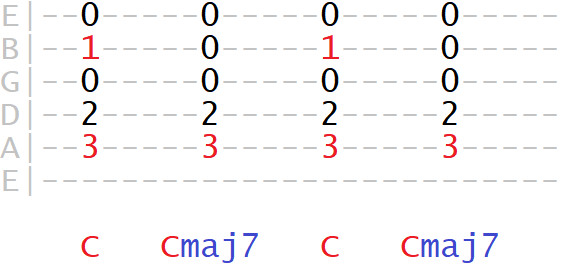 C major to C major 7 chord progression example
C major to C major 7 chord progression example
Furthermore, you might hear the tonic chord alternating between a basic major triad and a maj7 chord, creating subtle harmonic variation within a progression.
Major Key IV Chord
The IV chord, also known as the subdominant, in major keys is also commonly voiced as a major 7th chord. In the key of G major, for instance, Cmaj7 would be the natural IV chord, adding a smooth lift to the progression.
Minor Key III and VI Chords
In minor keys, major 7th chords frequently appear as the III and VI chords. For example, in A minor, Cmaj7 serves as the typical III chord.
Similarly, in E minor, Cmaj7 often functions as the VI chord, providing a characteristic harmonic movement.
Trust Your Ear
While understanding the theory behind major 7th chords and their typical usage is valuable, ultimately, your ear is the best guide. Don’t hesitate to experiment and use major 7th chords wherever they sound pleasing to you. Music theory provides a framework, but your creative intuition should always be the final judge.
In our next exploration, we’ll delve into more creative and less conventional ways to incorporate maj7 chords into your progressions, venturing beyond their typical diatonic roles. We’ll also explore extending major 7th chords further to unlock even richer harmonic textures. Stay tuned to continue expanding your major 7th chord vocabulary and musical expression!

